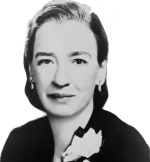 Grace Hopper
Grace Hopper
Queen of Code. Mother of Computing. Debugger.
Her contributions transformed the field of computer science and set the stage for the digital revolution
Related: AI History | AI Research | Biographies
.
Grace Hopper was a pioneering computer scientist, mathematician, educator, and US Navy Rear Admiral renowned for her contributions to computer programming

9 December 2013 Google Doodle honoring Grace Hopper
Grace Hopper's visionary contributions transformed the field of computer science and set the stage for the digital revolution. She played an instrumental role in the development of programming languages and the concept of machine-independent programming, which significantly shaped the computer science industry. She was instrumental in developing one of the first compiler programs and the COBOL programming language. Her legacy endures not only in the technologies we use, but also in the inclusive and innovative spirit she championed. As we continue to advance in the Age of AI, Hopper's pioneering work reminds us of the importance of curiosity, collaboration, and especially, breaking new ground.
 Key Achievements
Key Achievements
Grace Hopper coined the term "computer bug" and taught computers to "speak English"
- Programming of the first computer
- Worked on the Mark I and II computers and wrote the first computer manual, a 561 page document
- Developed the first compiler, which made higher-level languages possible
- Created FLOW-MATIC, the first English-language data processing compiler, used in the UNIVAC
- Led the development of COBOL, an early high-level programming language still in use today
- Credited with popularizing the term "debugging"
- One of the first and one of the longest serving officers in Naval history
- Received numerous, prestigious awards
- Inspired the Grace Hopper Celebration of Women in Computing
If you ask me what accomplishment I'm most proud of, the answer would be all the young people I've trained over the years; that's more important than writing the first compiler.
 Background
Background
The eldest of three children, Grace Hopper was born on December 9, 1906, in New York City. A naturally curious and driven individual, she demonstrated an early passion for learning and problem-solving. As a child, Grace Hopper was determined to figure out how clocks worked. To find the answer, she took apart every single alarm clock in the house. Her parents encouraged that curiosity and fostered her interest in math and engineering.
The most dangerous phrase in the language is, 'We've always done it this way'
She studied math and physics in college, although her interests were diverse. She graduated Phi Beta Kappa from Vassar College in 1928 with a degree in mathematics and physics, and Vassar granted her a Vassar College Fellowship to attend Yale. Hopper graduated from Yale University, earning a master's degree in 1930, and later a Ph.D. in mathematics in 1934, becoming one of the few women of her era to achieve such academic success. In 1930, she married Vincent Foster Hopper, an English instructor with the New York School of Commerce. They divorced in 1945, and they had no children. Grace never re-married.
 Military and the Mark I
Military and the Mark I
After the U.S. entered World War II, Hopper convinced Vassar College, where she was attending school and teaching students, to grant her leave so that she could enlist in the U.S. Navy Reserve. She had to overcome age and weight restrictions (she was 38 and 15 pounds underweight) to become one of the first women to serve in the Navy in 1943. After basic training, graduating tops in her class, she was assigned to Harvard University's Computation Laboratory to work on one of the world's first computers. She worked at the Bureau of Ordnance Computation Project at Harvard, along with professor and Naval Reserve officer Howard H. Aiken. Aiken was the principal engineer behind IBM's Harvard Mark I computer, which was considered the first large-scale automatic digital computer in the United States. The Mark I, officially the IBM Automatic Sequence Controlled Calculator, was one of the earliest electromechanical computers. The machine was 8 feet tall, 51 feet long, contained 750,000 parts, and weighed over 10,000 pounds.
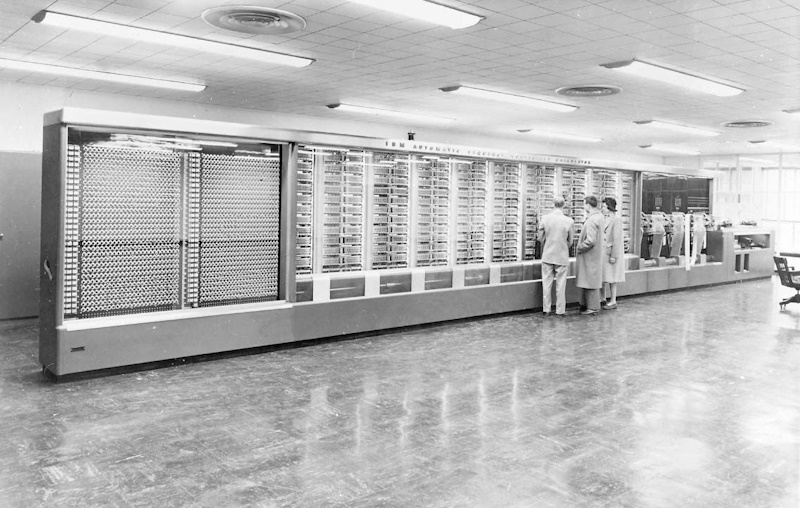
At Harvard, Hopper ran calculations to help in the war effort. These top-secret calculations included computing rocket trajectories, creating range tables for new anti-aircraft guns, and calibrating minesweepers. She principally worked with the Mark I, and played a critical role in programming it and documenting its operations. She was commissioned a lieutenant (junior grade) in the all-female WAVES in 1944. While still in the Navy, she became the first Director of Automatic Programming at Eckert-Mauchly Computer Corporation in 1954. The company, which was soon acquired by Remington Rand, had developed the first electronic computer (the ENIAC) under US Army contracts.
Hopper retired from the Navy in 1966. but was recalled to active duty in 1967 to standardize the Navy's use of high-level programming languages. She continued to serve until 1986, retiring as a Rear Admiral at the age of 79. When she retired, she was one of the longest-serving officers in Navy history and the oldest-serving officer in the United States Armed Forces. The year she retired she went to work as a senior consultant in public relations at Digital Equipment Corporation (DEC), makers of the PDP-11 computer where the C language was born. After retirement, she continued to teach and consult until her death in 1992. Grace Hopper was buried with full military honors in Arlington National Cemetery.
 Compilers
Compilers
Hopper is known for her pioneering work on compilers, programs that translate human-readable code into machine code. She recognized that programming computers in binary or assembly code was labor-intensive and prone to error. Compilers were required to bridge the gap between human-readable programming languages like COBOL and the low-level language of computers, binary or assembly code, used in her time. Compilers are essential for creating efficient, executable programs and play a key role in software development.

Her realization of the need for a compiling process led to her development of the Arithmetic Language version 0 System in 1952. A-0 was the first compiler, and for the first time it allowed programmers to use symbolic instructions instead of numeric code. Hopper's compilers paved the way for the creation of high-level programming languages, like COBOL, making programming more accessible and efficient.
 COBOL
COBOL
One of Grace's most famous contributions to computing was her work on the development of COBOL, an acronym for Common Business-Oriented Language. COBOL was one of the first high-level programming languages. As the name implies, it was intended for business use. COBOL introduced a more English-like syntax to programming languages, with the goal of enabling people with minimal programming experience to write code. COBOL subsequently became widely adopted in industry, and COBOL remains in use today for many legacy systems, particularly in banking and government.
The programs for the early computers like the Mark's all had to be made up of so-called machine instructions. These are the simplest operations the computer can do; such as to add two numbers, move data from a place in memory to a register (a place where arithmetic can be done in a subsequent operation), jump to a different instruction in the program, and so on. Programming in such basic machine language was difficlut and time consuming. Grace's idea was that you could write programs in a language closer to human language where each instruction in this high-level language stood for lots of machine instructions.
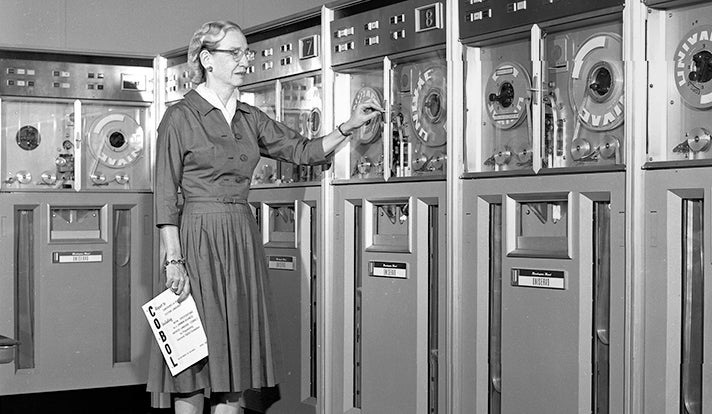
COBOL was the first widely used high-level programming language and became a standard for programming languages. By the 1970s, COBOL was the most extensively used computer language in the world. Her ideas made programming much easier to do and much less error-prone. Perhaps more importantly, larger programs were now possible. Grace Hopper was instrumental in pushing for standardization in programming languages, and it started with COBOL.
 The Famous Moth Incident
The Famous Moth Incident
The famous debugging moth incident occurred on September 9, 1947, at Harvard University, while Hopper was working on the Mark II Aiken Relay computer, a relay-based machine.
While testing the Mark II, Hopper and her team encountered an operational problem. Upon investigation, they discovered that a moth had become lodged in one of the computer's relays, causing a malfunction. The moth was carefully removed and taped into the team's logbook, accompanied by the humorous notation: "First actual case of bug being found." This incident gave rise to the popular use of the term "debugging" to describe the process of identifying and removing errors from computer systems, of testing and fixing a computer program in the modern sense of the term.
While Grace Hopper was part of the team that logged the incident, she didn't claim to have coined the term "debugging." Instead, she helped popularize the story, and the moth became an iconic part of computing lore. The term "bug" had been used in engineering and technical contexts long before this event. For example, Thomas Edison referred to mechanical glitches as "bugs" as early as the 19th century. Hopper was the first to refer to a computer problem as a "bug" and to speak of "debugging" a computer. She frequently shared the anecdote during her lectures, using it to emphasize the practical challenges of working with early computers.
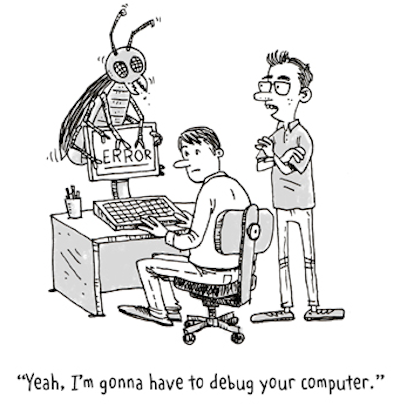
Did the term 'bug' come from this incident? Not entirely, since the term had already been used in engineering jargon to describe issues or flaws. However, the 1947 incident brought the term into the computing lexicon in a literal and memorable way. Hopper's storytelling helped solidify "debugging" as a fundamental part of the programmer's vocabulary.
The original logbook page, complete with the taped moth, is preserved at the Smithsonian National Museum of American History in Washington, D.C. This log book was probably not Hopper's, but she and the rest of the Mark II team helped popularize the use of the term computer bug and the related phrase "debug." The story underscores the mechanical nature of early computers, a stark contrast to the purely digital systems we use today.
The debugging moth story is a lighthearted yet symbolic reminder of the obstacles faced by early computer scientists. It highlights the meticulous, hands-on work required to maintain early machines and reflects the ingenuity of pioneers like Hopper, whose problem-solving laid the groundwork for modern computing.
 Awards and Recognition
Awards and Recognition
Grace Hopper has been recognized with numerous awards. She is remembered for her role in advancing computer science, particularly in making it more accessible through higher-level programming languages. Her work laid the foundation for user-friendly programming and large scale computing as well as computer accessibility.
Hopper received accolades for her contributions to computing, as well as her military service, including:
- The National Medal of Technology and Innovation (1991), the highest honor for technological achievement in the United States. The award was given "for her pioneering accomplishments in the development of computer programming languages that simplified computer technology and opened the door to a significantly larger universe of users."
- The Presidential Medal of Freedom (posthumously awarded in 2016).
- The naming of the USS Hopper, a guided-missile destroyer, in her honor. Hopper is only the second US Navy warship to be named for a woman from the Navy's own ranks.
- The Grace Hopper Celebration of Women in Computing, an annual conference for women in computing, is held in her honor. The Celebration is the world's largest gathering of female technologists.
- The first ever Computer Science Man-of-the-Year Award from the Data Processing Management Association in 1969.
- The Defense Distinguished Service Medal, awarded by the Secretary of Defense, and the Legion of Merit by the Navy.
 Legacy and Impact
Legacy and Impact
Grace Hopper's visionary contributions to computer science continue to shape the industry today, emphasizing the importance of making technology accessible to all users. Hopper's influence extends far beyond her technical achievements. She was a trailblazer who shattered barriers for women in science, technology, engineering, and mathematics (STEM). Her accomplishments demonstrated that women could excel in fields dominated by men, inspiring a movement toward gender equity in STEM. Hopper's work laid the foundation for the user-friendly programming languages and software systems we rely on today. Her foresight about machine-independent programming languages revolutionized the way we interact with computers. She inspired generations of programmers and engineers to think creatively and embrace change.
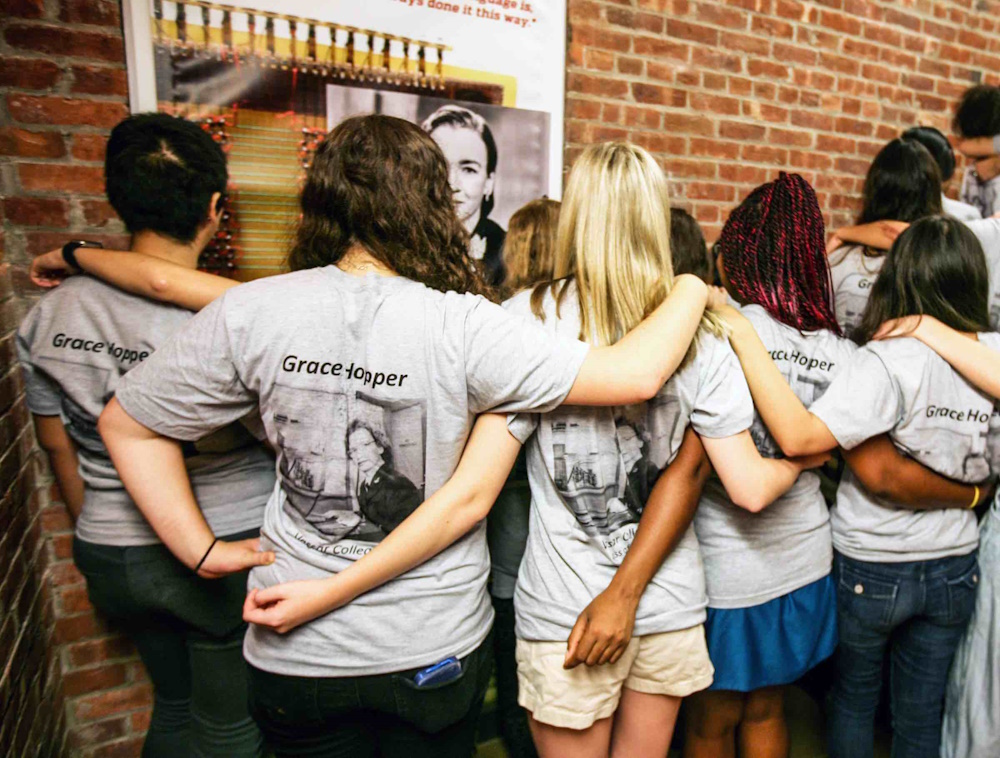
Grace Hopper was instrumental in developing one of the first compiler programs, which translates writing in a programming language into machine code. This work significantly simplified programming tasks and made higher-level languages possible. She created FLOW-MATIC, the first programming language using English-like commands, and COBOL, an early high-level programming language still in use today. Hopper is also credited with popularizing the term "debugging" after an incident where her team found an actual moth causing issues in the Harvard Mark II computer. Her association with the famous "debugging moth" is one of the most enduring anecdotes in computing history.
In her lectures, she often said that the world was only starting to know what to do with computers, and that if the power of the machines scared anyone, people could "always pull the plug." If only she could see how prescient that vision is today in the Age of AI.
 Links
Links
Grace Hopper: Queen of Computer Code
Grace Hopper and the Invention of the Information Age
news.yale.edu/2017/02/10/grace-murray-hopper-1906-1992-legacy-innovation-and-service
lemelson.mit.edu/resources/grace-hopper
en.wikipedia.org/wiki/Grace_Hopper
nationallanding.org/post/grace-murray-hopper-mathematician-navy-veteran-arlington-resident
computerhistory.org/profile/grace-murray-hopper/
wams.nyhistory.org/confidence-and-crises/world-war-ii/grace-hopper
mathshistory.st-andrews.ac.uk/Biographies/Hopper
womenshistory.org/education-resources/biographies/grace-hopper
tinyview.com/in-science-we-trust/2021/09/19/the-story-of-grace-hopper